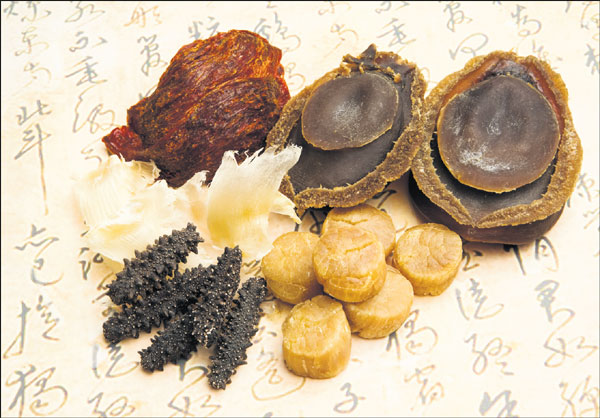Seafood delicacies year-round
Editor's Note: Traditional and fusion cooking styles, regional and international ingredients and a new awareness of healthy eating are all factors contributing to an exciting time for Chinese cuisine. We explore the possibilities.
Abalones, scallops, mussels, clams, sea cucumber, whelks, prawns, fish, cuttlefish ... practically everything from the sea can be preserved and dried, ready for another day in the Chinese kitchen.
Chinese fishermen are experts at preserving what they cannot sell the same day. At any seaside port, you can often smell these even before you see them - racks and rows of drying shellfish, baby prawns or tiny fish.
|
Dried seafood is preserved to make delicious dishes available out of season. Provided to China Daily |
And the chefs are waiting to resurrect all the condensed flavors with some clever processes. It could be as simple as pounding savory dried prawns and using them in a soup or stir-fry, or as involved as the one-week labor of love reconstituting a hardened abalone into a soft, tender morsel again.
Dried seafood is part of the repertoire of marine pleasures, the precious ingredients from the sea that are preserved to make delicious dishes available out of season.
On the lower end of the scale, dried prawns are the home cook's pantry basics.
In northern regions that are far away from the coasts and ports, this is how the Chinese add seafood flavors to their diet. Baby shrimps or krill are dried and stored. The xiapi or shrimp skins are used whole, shells and all, for there is little meat on them.
A simple everyday soup is to pour boiling hot water over krill and torn-up pieces of dried laver. A final garnish of coriander leaves, and a flavorful soup is ready in minutes.
Krill is also toasted in the wok and added to stir-fries of vegetables to add that touch of seafood umami. They are also used in dumplings to sweeten the filling.
Larger prawns, also naturally dried, are known as haimi or xiami the last character meaning "rice". These "prawn rice" are equally precious and sparingly used as a seasoning ingredient.
Long ago, Chinese fishermen discovered the secret of dehydration. Shellfish such as mussels, cockles, clams and whelks are shelled end then naturally dried in the sun when they are abundant. They are then stored for those times when ingredients are scarce, and used to enrich the dining table.
Drying enhances the natural sweetness of the shellfish, and dried whelks, mussels and clams are commonly used to flavor seasonal broths.
Some dried seafood can be very expensive.
Good-sized scallops cost a bomb, especially now when marine resources are being depleted so quickly. The best are found in the cold waters of the more northern latitudes, and a kilogram of dried scallops may set the determined gourmet back by a couple of thousand yuan.
Still, dried scallops (the round adductor muscles of the shellfish) are in great demand because they are an essential ingredient to so many banquet dishes.
When Spring Festival comes around, another mollusk will be in equal demand, either fresh or dried. The abalone is a treasured dish, and chefs will spend a lot of time preparing dried abalones so they lose none of their intense deliciousness.
The dried shellfish are soaked, then repeatedly blanched in hot ginger and scallion water baths till they soften. Then they are braised in broths made with chicken, Chinese ham and pork bones.
To the Chinese gourmet, the tender shellfish that is the result of such laborious effort is worth every bit of the trouble.
A simpler but no less flavorful option is a dish of dried oysters cooked with purplish black moss. The oysters, dried hard, are slowly braised in a pork belly reduction until their own flavors bloom and mix with the meat.
The hairlike strands of black moss soak up all the sweetness and are probably the most coveted mouthfuls. The name of the dish is facai haoshi, homophonic with "a prosperous marketplace", so it is especially beloved by businessmen diners.
Dried sea cucumbers are also an expensive seafood item. The hard, black wrinkled tubes hardly look appetizing at all in their raw state, but the alchemy in the Chinese kitchen turns them into a very famous signature dish in Lu or Shandong cuisine.
But before the chefs work their magic, they have to prep the sea cucumbers by repeated soakings and changing of water, including gentle simmering in ginger and scallion water to revive the collagen.
Then the great thick stems of Shandong Welsh onions are sliced thin and used to flavor the oil. Chicken stock creates a fragrant brown gravy that is used to cook the sea cucumbers.
The result is soft, gelatinous mouthfuls that are still springy and chewy but tender.
And then of course there are the dried fish.
Salted fish range from an overnight brining to a deeply fermented, pungently fragrant fish that melts in the mouth, with a variety of products in between.
From dried prawns and tiny salted anchovies to dried abalones and sea cucumbers, the range of products is testimony to the determination to have flavorful marine pleasures available all year round.
paulined@chinadaily.com.cn
Recipes
Fried rice with salted fish
2 cups cooked rice
100 g salted fish, bones removed
100 g minced pork
2 eggs, beaten
1-2 stalks spring onions, chopped
1 tablespoon minced ginger
Black pepper
Dice the salted fish. Heat up a deep frying pan with some oil and add salted fish. Fry till fragrant and lightly golden. Add ginger and spring onions.
Add the minced pork, tossing to break up clumps.
Add the rice and mix well. Pour the beaten egg down the side of the pan and allow to set for a minute. Stir into the fried rice mixture. Season with black pepper and additional salt, if necessary. Serve hot.
Steamed scallops and marrow
1 large marrow, or hairy gourd
8 whole dried scallops, soaked overnight
1 cup chicken stock
1 tablespoon cornstarch in 1 tablespoon water
Wolfberries for garnish
Peel and cut the marrow into eight sections. Hollow out the centers and remove the pith.
Place a soaked dried scallop into each marrow section. Arrange in a deep platter. Mix the cornstarch slurry with the chicken stock and carefully pour over the marrow. Sprinkle some salt and pepper.
Steam over high heat for 20 minutes. Remove and add wolfberries for garnish. Serve immediately.
Spicy mussels
300 g dried mussel meat
1 tablespoon minced garlic
1 tablespoon minced ginger
1 tablespoon minced chili peppers
2 stalks spring onions, chopped
1 tablespoon hot bean paste (doubanjiang)
Salt and pepper
Rinse the dried mussels and soak in plenty of water for an hour. Drain and dry.
Heat up oil in a frying pan and add garlic, ginger and chopped chili. Fry over high heat till fragrant and slightly crisp, stirring all the while.
Add mussels and hot bean paste, then season to taste with salt and pepper. Finally, add half the spring onions and toss well.
Garnish with remaining spring onions and serve hot.



















